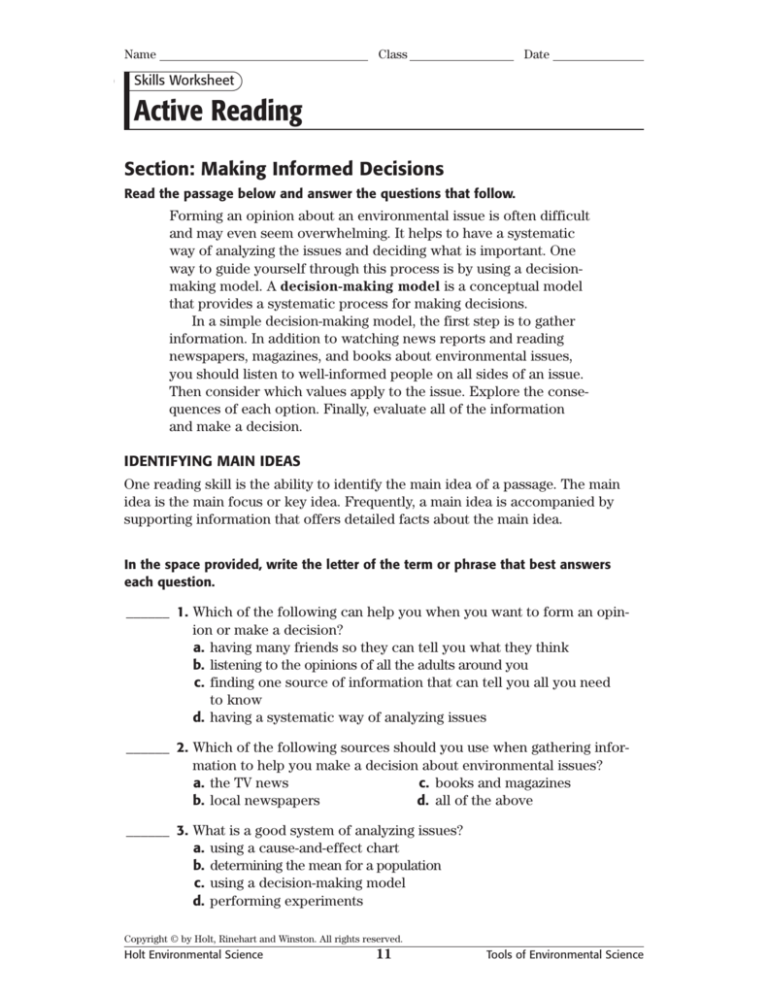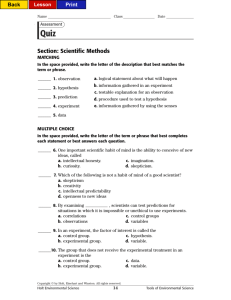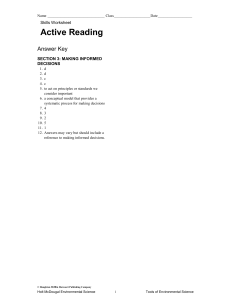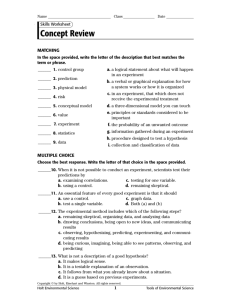
Name
Class
Date
Skills Worksheet
Active Reading
Section: Making Informed Decisions
Read the passage below and answer the questions that follow.
Forming an opinion about an environmental issue is often difficult
and may even seem overwhelming. It helps to have a systematic
way of analyzing the issues and deciding what is important. One
way to guide yourself through this process is by using a decisionmaking model. A decision-making model is a conceptual model
that provides a systematic process for making decisions.
In a simple decision-making model, the first step is to gather
information. In addition to watching news reports and reading
newspapers, magazines, and books about environmental issues,
you should listen to well-informed people on all sides of an issue.
Then consider which values apply to the issue. Explore the consequences of each option. Finally, evaluate all of the information
and make a decision.
IDENTIFYING MAIN IDEAS
One reading skill is the ability to identify the main idea of a passage. The main
idea is the main focus or key idea. Frequently, a main idea is accompanied by
supporting information that offers detailed facts about the main idea.
In the space provided, write the letter of the term or phrase that best answers
each question.
______ 1. Which of the following can help you when you want to form an opinion or make a decision?
a. having many friends so they can tell you what they think
b. listening to the opinions of all the adults around you
c. finding one source of information that can tell you all you need
to know
d. having a systematic way of analyzing issues
______ 2. Which of the following sources should you use when gathering information to help you make a decision about environmental issues?
a. the TV news
c. books and magazines
b. local newspapers
d. all of the above
______ 3. What is a good system of analyzing issues?
a. using a cause-and-effect chart
b. determining the mean for a population
c. using a decision-making model
d. performing experiments
Copyright © by Holt, Rinehart and Winston. All rights reserved.
Holt Environmental Science
11
Tools of Environmental Science
Name
Class
Date
Active Reading continued
______ 4. Whose opinions should you seek when you are trying to make a decision?
a. your relatives’ and teachers’
b. your friends’
c. well-informed people’s on all sides of the issue
d. well-informed people’s on the side of the issue that best matches
your values
VOCABULARY DEVELOPMENT
Read each question and write the answer in the space provided.
5. The suffix -ate means “to act on.” If the word values means “principles or
standards we consider important,” what is the meaning of the word evaluate?
6. What is a decision-making model?
SEQUENCING INFORMATION
One reading skill is the ability to sequence information, or to logically place items
or events in the order in which they occur.
Sequence the statements below to show the steps of the decision-making model.
Write “1” on the line in front of the first step, “2” on the line in front of the second
step, and so on.
______ 7. Evaluate all the information.
______ 8. Explore the consequences of each option.
______ 9. Consider which values apply to the issue.
______10. Make a decision.
______11. Gather information from many sources.
RECOGNIZING CAUSE AND EFFECT
Read the question and write the answer in the space provided.
12. What is one effect of using a decision-making model?
Copyright © by Holt, Rinehart and Winston. All rights reserved.
Holt Environmental Science
12
Tools of Environmental Science
TEACHER RESOURCE PAGE
Active Reading
8.
9.
10.
11.
12.
SECTION: SCIENTIFIC METHODS
1. A single variable is tested; a control
is used.
2. They study two groups or situations at
a time.
3
2
5
1
Answers may vary but should include
a reference to making informed
decisions.
3. to pinpoint cause and effect
relationships
Map Skills
4. control group
5. experimental group
6. everything except the variable being
1. maple-beech-birch; oak-hickory
2. Answers may vary but students should
studied
notice a general northward migration
of tree species.
3. Answers may vary but students
should conclude that if the maple
tree population declines, this could
destroy the maple syrup industry in
New England.
4. Answers may vary but students
should suggest further modeling and
making first-hand observations of
actual temperature change and
species migration over time.
7. the level of phosphate in the water
8. a
9. Using both helps determine whether
or not a hypothesis is correct.
10. Phosphate in the water is killing the
mussels.
SECTION: STATISTICS AND MODELS
1. Individuals in a population have differ2.
3.
4.
5.
6.
7.
8.
9.
10.
11.
12.
ent characteristics.
by determining a mean
by adding up the data for a given characteristic and dividing this sum by the
number of individuals for which data
was collected
d
c
a
4
5
2
1
3
Answers may vary. Sample answer:
Scientists can easily compare different
populations by comparing their means.
Quiz
SECTION: SCIENTIFIC METHODS
Matching
1. e
2. c
3. a
4. d
5. b
Multiple Choice
6. c
7. c
8. a
9. d
10. a
SECTION: STATISTICS AND MODELS
Matching
1. c
2. b
3. a
4. a
SECTION: MAKING INFORMED
DECISIONS
1.
2.
3.
4.
5.
d
d
c
c
to act on principles or standards we
consider important
6. a conceptual model that provides a
systematic process for making
decisions
7. 4
Multiple Choice
5. b
6. b
7. d
8. d
9. c
10. a
SECTION: MAKING INFORMED
DECISIONS
Matching
1. d
2. e
3. a
4. b
5. c
Multiple Choice
6. c
7. a
8. d
9. b
10. b
Copyright © by Holt, Rinehart and Winston. All rights reserved.
Holt Environmental Science
94
Tools of Environmental Science









